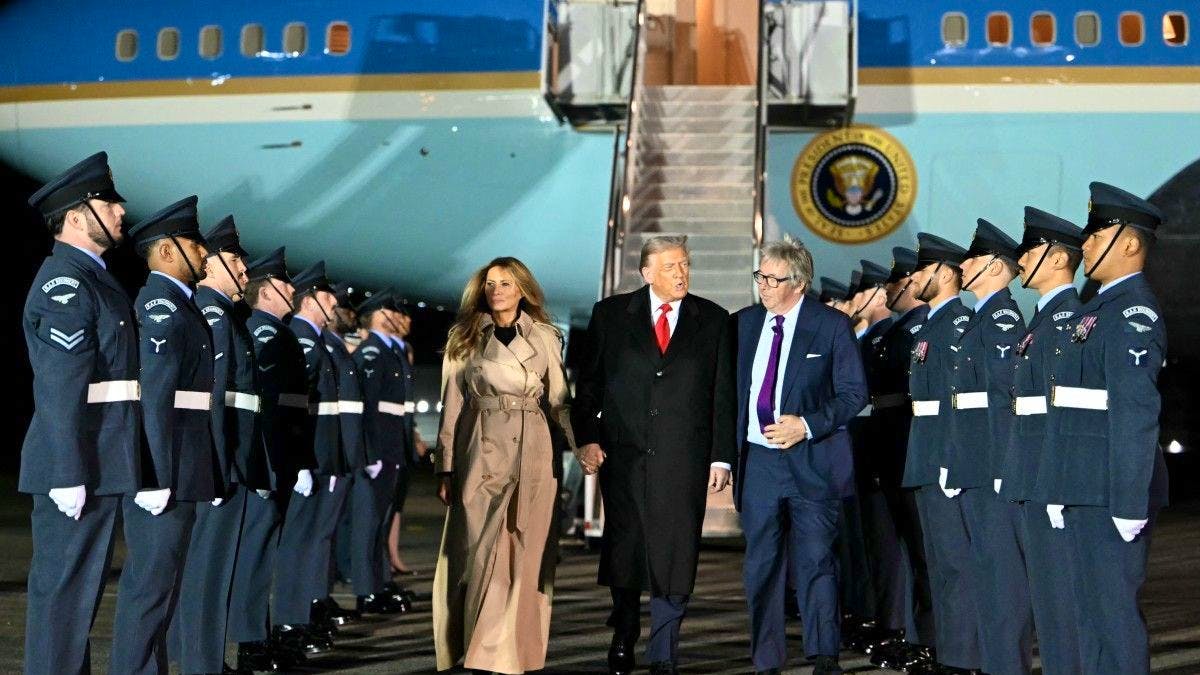Carriage ride, giant guard of honor, unprecedented aerial parade: the United Kingdom is pulling out all the stops for the second state visit of Donald Trump, received Wednesday in Windsor by Charles III, sheltered from demonstrations.
“This is going to be a very big day,” commented Mr. Trump upon arriving in the United Kingdom on Tuesday evening, looking forward to seeing the king, his “long-time friend.”
Surrounded by exceptional security, this two-day state visit begins with a spectacular display of royal pomp, of which the Republican leader is fond, and a military ceremony of unprecedented scale, involving 1,300 members of the British armed forces.
“They say Windsor Castle is the best, right? So it’s going to be great,” said Donald Trump, 79, before his departure from Washington, also congratulating himself on being the only American president to have twice the honors of a state visit to the United Kingdom. The first took place in 2019.
The president and his wife Melania will be welcomed at midday in this royal estate located west of London, first by Crown Prince William and his wife Catherine, then by King Charles III, 76, and Queen Camilla, 78.
However, uncertainty surrounds Camilla’s presence: the queen consort is recovering from acute sinusitis which prevented her from attending a royal funeral on Tuesday.
After a royal salute fired from the castle and from the Tower of London, the three couples must participate in a carriage procession, but always within the grounds of the estate, and not in the streets of the city as was the case during the state visit of French President Emmanuel Macron in July.
Marching band and bagpipes
Donald Trump will have the unique privilege of reviewing a guard of honor exceptionally comprising three regiments of the Royal Guard, accompanied by a fanfare, drums and bagpipes in the square courtyard of the castle.
After a private lunch with the royal family, the Trump couple will lay flowers on the grave of Queen Elizabeth II, who died in September 2022, in St George’s Chapel.
An air parade, combining in a unique way British and American F35 combat aircraft, and the aerobatic patrol of the “Red Arrows”, will precede the traditional royal banquet with some 150 guests.
A profusion of honors likely to flatter the ego of the American billionaire, who earlier this year compared himself to a monarch.
But 40 km away, thousands of demonstrators are expected in central London, to protest against the arrival of a very unpopular president in the country. The rally calling for the “Stop Trump” coalition, scheduled from 2 p.m., will be supervised by more than 1,600 police officers. Others are planned elsewhere in the UK.
The second day of the visit, Thursday, will be devoted to a more political sequence, which will take place at Checkers, the country residence of Prime Minister Keir Starmer.
The press conference could give rise to embarrassing questions for the two leaders, particularly relating to the Jeffrey Epstein affair. It came back to haunt Keir Starmer this week, who fired his ambassador to Washington Peter Mandelson, after revelations about his links with the American sex offender, who died in prison in 2019.
A subject that Donald Trump could do without, who has seen his presidency also poisoned by the Epstein affair for weeks.
Images of the American financier were also broadcast Tuesday evening by an anti-Trump group on a tower of Windsor Castle.
For its part, Keir Starmer’s government, economically weakened and in the midst of a political crisis, is seeking to take advantage of this visit to increase the number of announcements, between an agreement on tech and American investments.
It has already seen a massive investment of $30 billion (25 billion euros) from Microsoft, another of 5 billion pounds (5.8 billion euros) from Google and the announcement of a partnership including OpenAI and Nvidia to develop infrastructure dedicated to AI in the north-east of England.
A more general partnership to boost technological cooperation in AI, quantum and nuclear is to be signed during the visit, but its contours are still unclear.
The hopes of an agreement to lower the customs duties currently applied to whiskey (10%) and steel (25%) appear, however, to have been dashed, according to the British press.

